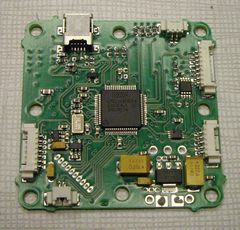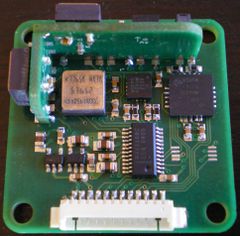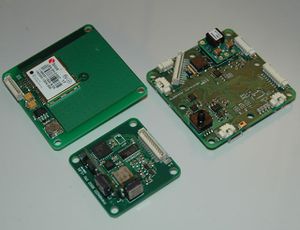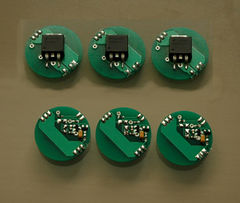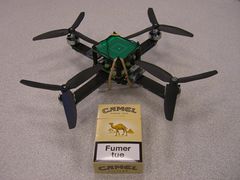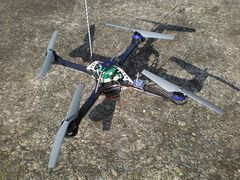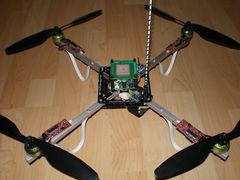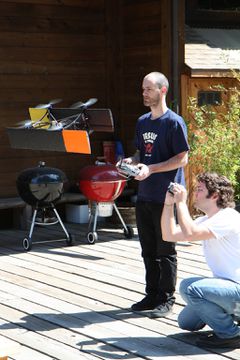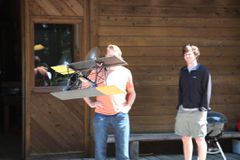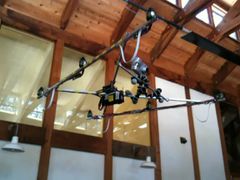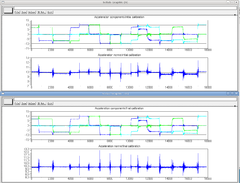Booz
Overview
Booz is an extension of Paparazzi to VTOLs. At the current stage of the project, the system provides attitude stabilization, vertical guidance and automatic navigation. It is able to use simple Paparazzi flight plans ( only go instructions ) and uses Paparazzi telemetry and datalink, which means all the Paparazzi ground segment applications are available( plotter, settings, gcs, etc...)
The current autopilot consist in 3 boards
- The main board, comprising power supply, a LPC2148 and a barometer.
- The IMU board, comprising gyroscopes, accelerometers, magnetometers and a 16 bits ADC.
- The GPS board, using a LEA-5H by ublox.
Additional Booz boards:
- The "power" board.
It flies on a variety of Quad-rotor platforms
and less common vehicles
Program Sources
Everything is at savannah.
-hardware in paparazzi4/trunk/hw/booz -code in paparazzi3/trunk
Hardware
Motor controllers
Booz is able to handle a number of quadrotor specific brushless motor controllers.
more info in BoozMotorControllers
Power board
The power board allows to switch power on and off on your vehicle as well as to make a clean wiring by avoiding wired Y
IMU
Booz has support for its custom designed IMU as well as for Cloudcap Crista IMU
Autopilot
Airframes
Purchasing Hardware
There are now vendors offering Booz hardware, Please see the Get Hardware page for details.
Building Tips
Since the Booz uses the same LPC2148 as the Tiny and TWOG autopilots and runs the same core code the documented steps are nearly the same for booz. Below more Booz specific tests are given. However after assembly you load the bootloader in the same way to enable programming via the USB interface.
Assembly Tips
- BOM
- Assembly Notes
- Expected voltages for newly created boards
Loading the USB Boot Loader
This is virtually the same steps as for all other LPC2148 based Paparazzi autopilots. Just the cable is different. Using UART0/serial to load the image.
Create an adapter cable that has Tx/Rx and Ground along with the ability to hold P0.14 low (i.e. grounded). My cable has P0.14 pin connected to ground as I have found P0.14 should be held low during the entire upload process. See the Eagle Schematic for the pinouts on the GPS connector you will use to upload (same connector as the Tiny/TWOG). NOTE: You can not use the same cable as the Tiny/TWOG.
Steps:
- Connect the "USB to FTDI cable" (#1 above) TTL ends to 8-pin Picoblade to FTDI board cable
- Connect the USB end to your Linux laptop (/var/log/messages should show a new device on /dev/ttyUSB0).
- Connect 8-pin adapter cable to "GPS" 8-pin Pico-Female on Booz Main "GPS" labeled connector
- Using common ground" set BOOT (P0.14) "low" and keep it held low (on GPS connector)
- Power on (~5v to 12v current limited power supply suggested)
- Enter this command in a terminal:
make upload_bl PROC=GENERIC
NOTE: Success will mean you see this at the end in the terminal:
Synchronizing. OK Read bootcode version: 2.12.0 Read part ID: LPC2148, 512 kiB ROM / 40 kiB SRAM (67305253) Sector 0: .................................................. ............................................. Sector 1: .................................................. ......................... Download Finished... taking 6 seconds Now launching the brand new code ioctl get failed ioctl set ok, status = 0 ioctl get ok, status = 2 ioctl get ok, status = 2 ioctl set ok, status = 2 ioctl set ok, status = 0 ioctl set ok, status = 0
What you need to see is the "Download Finished" message. Now you can remove Jumper and FTDI cable. From now on all programming is loaded using USB Adapter cable
USB Programming
Once the USB boot code is loaded (see above) you now program the autopilot via USB. To enable the LPC2148 to wait for programming on the USB interface you must power the board while the USB is connected to the ground station computer. When properly wired P0.21 will be fed 5v from the USB interface and at boot time that tells the LPC2148 to wait for programming over USB. Once programmed the board will rest itself and run the programming (even if you leave the cable attached).
Steps
- Connect the USB cable from the computer to the Booz Main USB connector
- Power on the Booz Main board
- On the Linux (computer) side dmesg should show you a new detected USB device
- In Paparazzi Center click "Upload" and wait for the ####### message to show the code is being uploaded.
That's it.
Running a simulator
Hardware Test
Booz comes with a number of simple test programs that you can use to validate a newly assembled board or learn how booz code works in case you want to extend it. The Makefile for those is in conf/autopilot/booz2_test_progs.makefile
test_downlink
Paparazzi's Makefile allow you to build different TARGETS (aka programs) using a doted notation. The begining of the Makefile reads
#
# test downlink
#
test_downlink.ARCHDIR = $(ARCHI)
test_downlink.ARCH = arm7tdmi
test_downlink.TARGET = test_downlink
test_downlink.TARGETDIR = test_downlink
#
test_downlink.CFLAGS += -DBOARD_CONFIG=$(BOARD_CFG) $(BOOZ_CFLAGS)
test_downlink.CFLAGS += -DPERIPHERALS_AUTO_INIT
test_downlink.srcs += $(SRC_BOOZ_TEST)/booz2_test_downlink.c
test_downlink.CFLAGS += -DUSE_LED
test_downlink.CFLAGS += -DPERIODIC_TASK_PERIOD='SYS_TICS_OF_SEC((1./10.))' -DTIME_LED=1
test_downlink.srcs += sys_time.c $(SRC_ARCH)/sys_time_hw.c $(SRC_ARCH)/armVIC.c
#
test_downlink.CFLAGS += -DUSE_UART1 -DUART1_BAUD=B57600
test_downlink.srcs += $(SRC_ARCH)/uart_hw.c
#
test_downlink.CFLAGS += -DDOWNLINK -DDOWNLINK_TRANSPORT=PprzTransport -DDOWNLINK_DEVICE=Uart1
test_downlink.srcs += downlink.c pprz_transport.c
FIXME: More on this when syntax highlighting/line numbering works
The command line to compile the "test_downlink" target for the BOOZ2_A1 aircraft would be
make AIRCRAFT=BOOZ2_A1 test_downlink.compile
and to upload this program to your board ( you don't really need to type the previous command, make is smart and will compile your program if needed when you ask him to upload it )
make AIRCRAFT=BOOZ2_A1 test_downlink.upload
test_max1168
the max1168 is the 16 bits analog to digital converter chip used on the IMU to sample gyros and accels.
make AIRCRAFT=BOOZ2_A1 test_max1168.upload
Sensors Calibration
All our sensors needs to be calibrated in order to provide useful informations.
Accelerometers and Magnetometers calibration is critical for AHRS performances and can be performed using no special hardware. For the magnetometer, it is even very important that the calibration be performed in the fully assembled vehicle, with all systems powered. This is the so-called hard-iron calibration and will allow us to compensate for any constant parasitic magnetic field generated by the vehicle. The calibration process consist in finding a set of neutrals and scale factors for each sensor, such as
The principle of the calibration is the following : An accelerometer, on a vehicle at rest measures a constant vector ( the opposite of gravity ) in the earth frame, expressed in the vehicle frame.
DCM is a rotation matrix that converts between earth frame and body frame. It will change when we change the orientation of the vehicle. Nevertheless, a rotation conserves the norm of a vector. We can thus obtain the following scalar equation that doesn't depend on the vehicle orientation :
We can then record an important number of measurements in different orientations and find the set of scale factor and neutral giving the norm closest to 9.81
Booz comes with a ( very unfriendly ) scilab script to perform this operation ( sw/tools/calibration/calib_accel_mag.sce ). Here is the way to use it
Switch to the "raw sensors" telemetry mode and launch "server" to record a log.
Move the quad in different orientations ( upright, inverted, on nose, on tail, on right side, on left side ) . You can also take some measurememts banking 45 degres.
Try to get an homogeneous distribution of your measurements. I find it better to let the quad rest while measuring. You can then run the scilab script to get your calibration coefficients. It first makes an initial guess using min and max, ie for each axis
neutral = 0.5 * (max + min)
sensitivity = 0.5*(max-min)
It then uses scilab's "datafit" algorithm to optimise the initial guess
Note for magnetometer:
